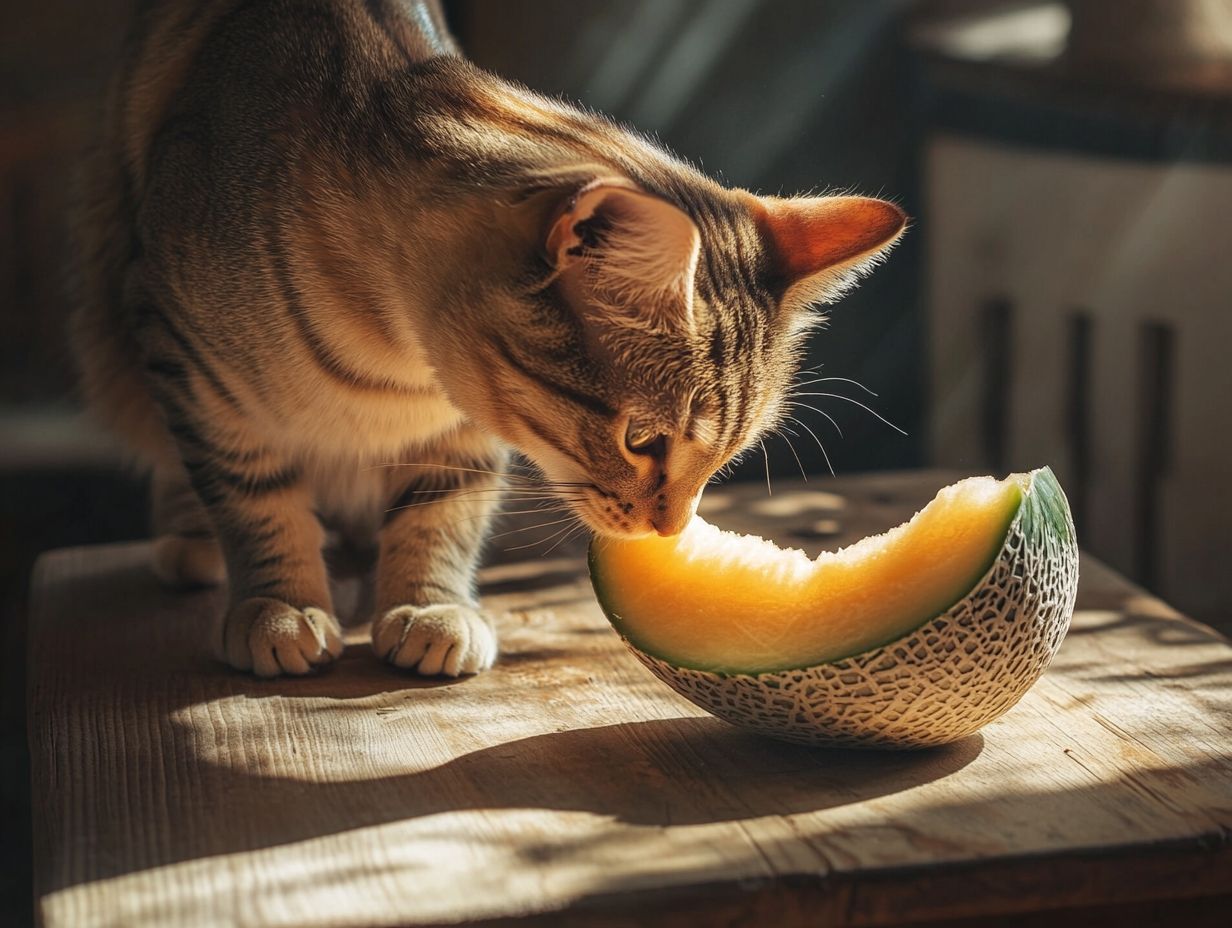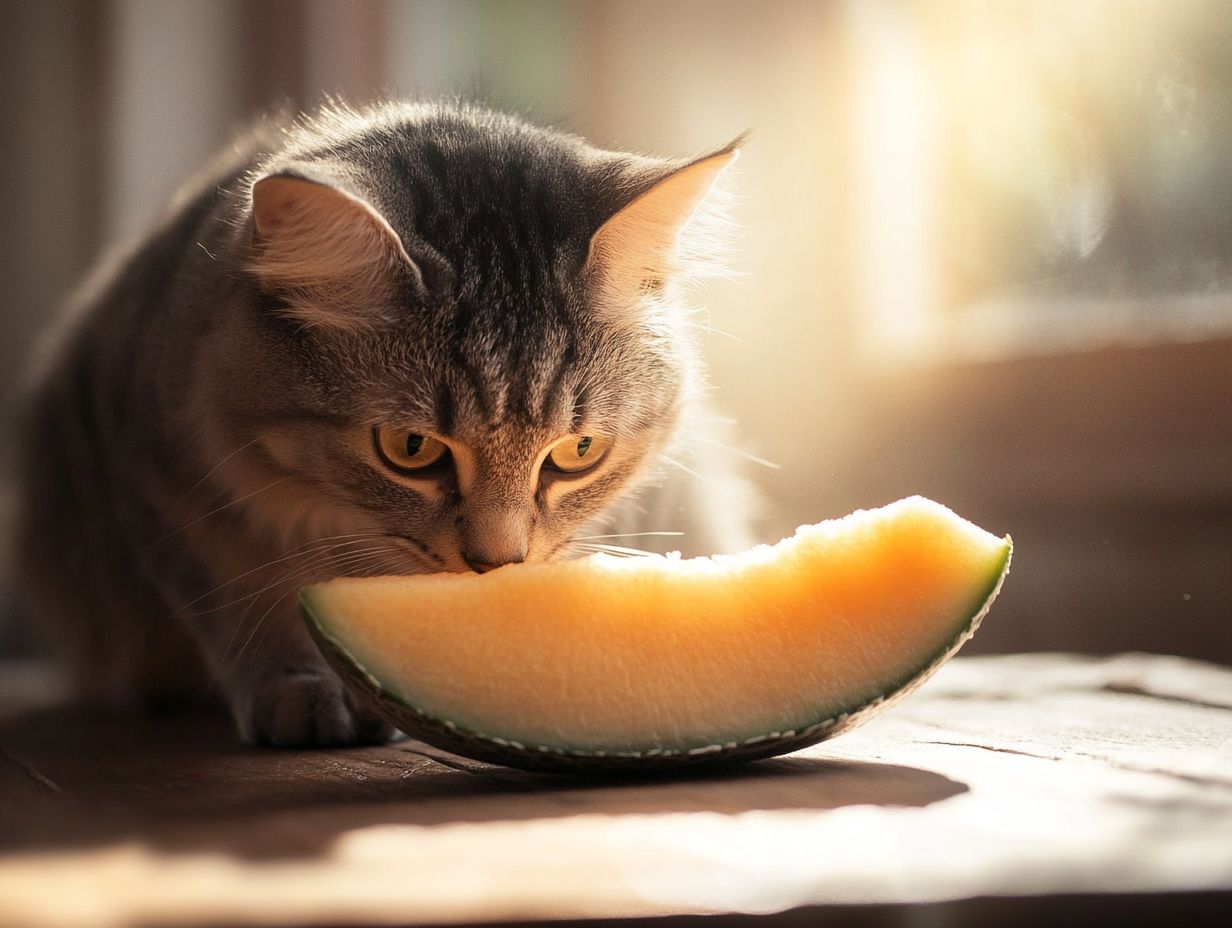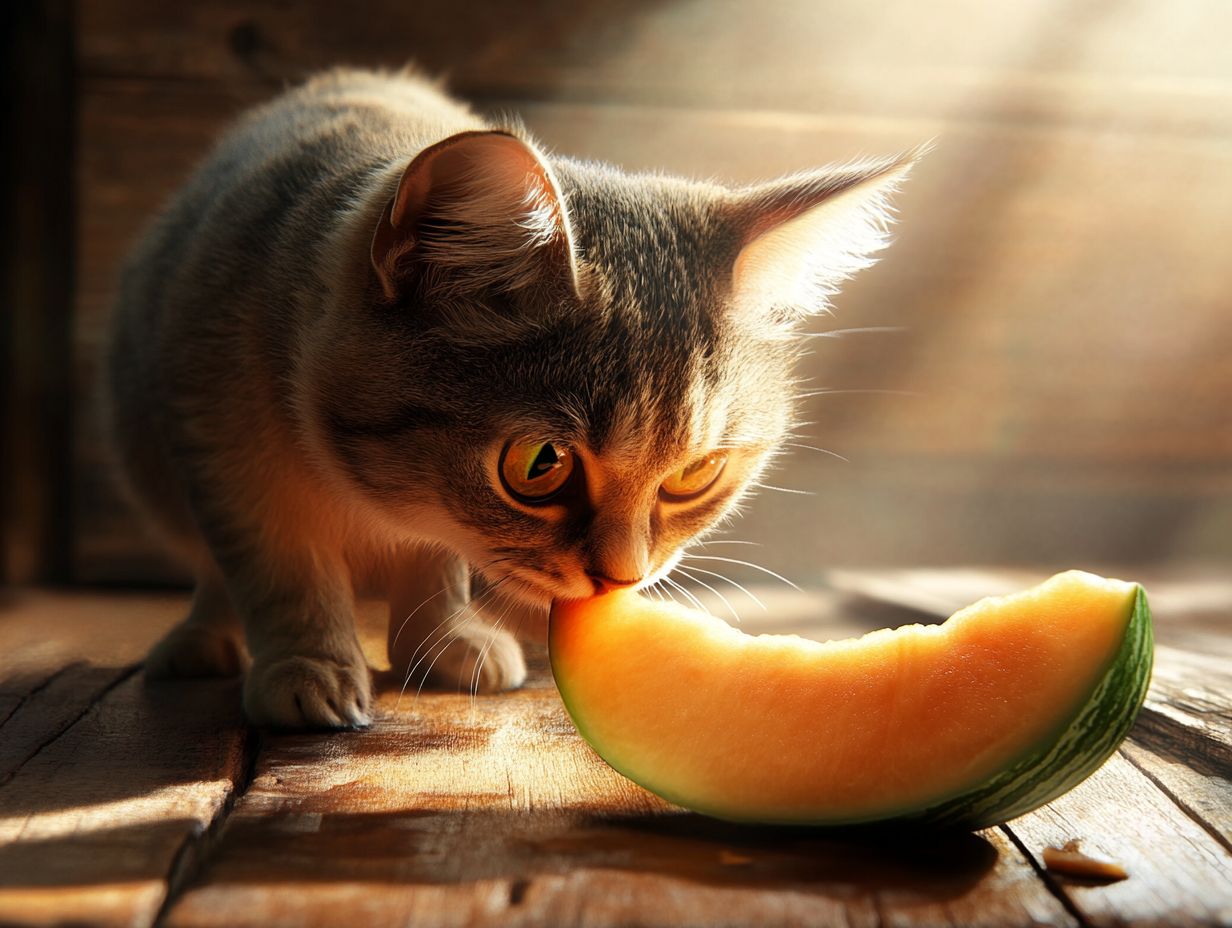Curious about whether your feline friend can enjoy a taste of cantaloupe, and if it’s a safe choice for cats? Before introducing any new food, it’s essential to consult your veterinarian to ensure your cat’s health.
This article explores the safety of feeding cantaloupe to cats, highlighting both its potential health risks and nutritional benefits, including how cats can thrive on this sweet fruit when given in moderation.
It breaks down the key vitamins and minerals found in this refreshing fruit, provides tips on how to safely serve it to your cat, and suggests alternative fruits and vegetables for variety.
Discover how to keep your cat healthy and happy with the right treats, ensuring their dietary needs and nutritional requirements are met!
Key Takeaways:

- Cantaloupe can be a safe and nutritious treat for cats, but be aware of potential health issues and benefits before feeding it to your feline friend.
- Cantaloupe is a good source of key vitamins and minerals for cats, including vitamin A, vitamin C, and potassium, which can support their overall health and well-being.
- When feeding cantaloupe to your cat, limit the serving size to a small cube (about 1 inch) or 1-2 teaspoons, and remove any seeds or rind to avoid choking hazards. Consider offering other cat-friendly fruits and vegetables as alternatives.
Is Cantaloupe Safe for Cats?
Cantaloupe is a fruit known for its sweet taste and high water content, making it a popular treat among some pet owners for their cats. Cats enjoy this sweet fruit due to its refreshing flavor.
However, it is crucial for pet parents to understand the safety of cantaloupe for cats and the potential health risks associated with feeding it to them. According to veterinarians and the American Society for the Prevention of Cruelty to Animals (ASPCA), while some cats may enjoy the taste of cantaloupe due to its aroma compounds, introducing any new food should be done in strict moderation to avoid digestive disorders.
This approach ensures that a cat’s nutritional needs and digestive health are maintained, avoiding potential issues that could arise from overconsumption.
Potential Risks and Benefits
Feeding cantaloupe to cats presents both health benefits and risks. Here are some key points:
Benefits of Cantaloupe:
- Low in calories
- Rich in vitamins A and C
- Contains antioxidants like beta-carotene, supporting skin and vision health
- Boosts immune system function
Risks of Cantaloupe:
- Digestive disorders if overconsumed
- Cats primarily need protein, so any plant-based foods should be introduced with caution
- Excessive intake could lead to diabetes or pancreatitis due to high sugar content
When introducing cantaloupe to a cat’s diet, it should be done gradually, with the owner monitoring for any adverse reactions. Always consult your veterinarian before introducing any new food to your cat’s diet for professional advice.
Ultimately, the benefits and risks of feeding cantaloupe to cats must be carefully balanced to maintain their health and well-being.
Nutritional Value of Cantaloupe for Cats
Cantaloupe is a fruit with low protein content, but it can be a unique addition to a cat’s diet. While it offers moderate nutritional value, when given in moderation, it can support their overall well-being and help them obtain nutrients.
Cantaloupe is rich in vitamins, including vitamins A and C, as well as minerals such as magnesium, potassium, and iron, which are essential for various bodily processes. However, it is important to note that cats need protein to survive and thrive, meaning they cannot rely solely on this fruit to meet their dietary needs.
Additionally, cats require a limited yet significant amount of carbohydrates, an essential consideration when introducing fruits and vegetables like cantaloupe into their diet, given their specific carbohydrate requirements.
Key Vitamins and Minerals

Always monitor your cat for any adverse reactions when introducing new foods, ensuring a balanced and healthy diet!
This article discusses the safety, benefits, and guidelines for feeding cantaloupe to cats. Cantaloupe is rich in essential vitamins and minerals, positively impacting a cat’s diet. The antioxidants found in cantaloupe support the immune system by combating harmful substances in the body, which can promote overall health in cats.
Key vitamins such as vitamin A and vitamin C support immune function and promote healthy skin and vision in cats. Research shows that vitamin A is crucial for maintaining good vision, while vitamin C contributes to skin health and overall vitality. Additionally, this fruit provides potassium, an important mineral needed for proper muscle function and overall wellness in felines.
The high water content in cantaloupe can also aid urinary health, particularly for cats that do not drink enough water. However, it is important to remember that cantaloupe should only supplement a cat’s primary diet, which should be rich in protein and tailored to meet their specific nutritional needs. Feeding too much can cause digestive issues like vomiting or diarrhea.
Striking a balance between treats like cantaloupe and a cat’s overall nutritional requirements contributes to a happier and healthier feline.
How to Feed Cantaloupe to Cats
When offering cantaloupe to your cats, ensure their safety by being mindful of serving size and preparation.
- Serving size: Cats should only be given small amounts of this sugary fruit. The recommended serving size is about 1 tablespoon for an average-sized cat, but portion sizes may vary depending on the cat’s weight and health condition.
- Preparation: Always remove the seeds and rind before giving cantaloupe to your cat, as these parts of the fruit can pose choking hazards.
Serving Size and Preparation Tips
Cats should be offered appropriate serving sizes of cantaloupe to ensure their health and safety. Start by giving only a small piece—no more than 1 tablespoon—and observe how your cat reacts before considering larger portions. It is crucial to introduce cantaloupe gradually to prevent any adverse reactions.
Cantaloupe should be served after washing the fruit, removing the seeds, and cutting it into small, bite-sized pieces to prevent choking hazards. This way, cats can enjoy this treat safely.
Offering this sweet treat in moderation—such as once every few weeks—can help avoid potential gastrointestinal discomfort and contribute to a healthy diet.
Alternatives to Cantaloupe for Cats
While cantaloupe can be a suitable snack for some cats, it may be beneficial to explore other safe options that meet their nutritional needs. Many fruits and vegetables can be safe for cats, provided they are low in sugar and offered in strict moderation.
- Cooked pumpkin is a tasty option that provides hydration and essential nutrients.
- Seedless watermelon is also hydrating and safe in small amounts.
- Blueberries are rich in antioxidants and can make a tasty snack.
- Peas provide plant-based protein and fiber.
- Steamed or lightly cooked vegetables, such as carrots or green beans, can also be included in a cat’s diet.
It is essential to ensure that any treats given to cats are safe and offered in small portions to prevent potential digestive issues. Always monitor individual cats for any adverse reactions when introducing new foods.
Frequently Asked Questions
In conclusion, consulting your veterinarian before introducing new foods to your cat’s diet is always a wise choice. This ensures that you are making the best decisions for your pet’s health and well-being.
If you’ve ever wondered whether your feline friend can enjoy a slice of fruit, you’re not alone. Many cat owners are curious about the safety and benefits of feeding their pets cantaloupe. Let’s explore this topic in depth.
Can Cats Eat Cantaloupe?
Yes, cats can safely eat cantaloupe in small amounts as an occasional treat.
Why is Cantaloupe a Good Addition to a Cat’s Diet?
Cantaloupe is a good source of vitamins A and C, potassium, and fiber, which can benefit a cat’s overall health. These nutrients support healthy vision, immune function, and digestion.
How Should I Prepare Cantaloupe for My Cat?

Remove the rind and seeds, and cut the cantaloupe into small, bite-sized pieces. Start with a piece no larger than a marble to ensure your cat doesn’t have an adverse reaction. Serve it to your cat in moderation.
Can Cats Eat Cantaloupe Seeds?
No, cats should not eat cantaloupe seeds. They can be a choking hazard and may also contain harmful compounds.
Are There Any Risks to Feeding My Cat Cantaloupe?
Cantaloupe is safe for cats when given in moderation, but be aware of potential risks. Too much cantaloupe can upset a cat’s stomach and lead to diarrhea. Watch for signs of gastrointestinal upset, such as vomiting or lethargy.
What Other Fruits Can Cats Eat?
In addition to cantaloupe, some other fruits safe for cats in moderation include bananas, blueberries, and watermelon. Always remove seeds, pits, and rinds before serving to your cat.
Conclusion
While fruits like cantaloupe can be a fun treat for your cat, they should not replace a cat’s regular nutrition. Always consult a veterinarian for personalized dietary advice to ensure your pet’s health and well-being.
Common Signs of Adverse Reactions
- Vomiting
- Diarrhea
- Lethargy
- Loss of appetite